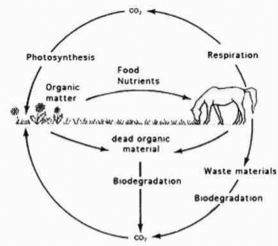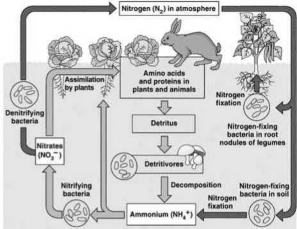(b) The Carbon Cycle
Carbon is a minor constituent of the atmosphere as compared to oxygen and nitrogen. However, without carbon dioxide life could not exist, because it is vital for the production of carbohydrates through photosynthesis by plants. It is the element that anchors all organic substances from coal and oil to DNA (deoxyribonucleic acid: the compound that carries genetic information).
Carbon is present in the atmosphere, mainly in the form of carbon dioxide (CO2). Carbon cycle involves a continuous exchange of carbon between the atmosphere and organisms. Carbon from the atmosphere moves to green plants by the process of photosynthesis, and then to animals. By process of respiration and decomposition of dead organic matter it returns back to atmosphere. It is usually a short term cycle.
Some carbon also enters a long term cycle. It accumulates as un-decomposed organic matter in the peaty layers of marshy soil or as insoluble carbonates in bottom sediments of aquatic systems which take a long time to be released.
In deep oceans such carbon can remained buried for millions of years till geological movement may lift these rocks above sea level. These rocks may be exposed to erosion, releasing their carbon dioxide, carbonates and bicarbonates into streams and rivers.
Fossil fuels such as coals, oil and natural gas etc. are organic compounds that were buried before they could be decomposed and were subsequently transformed by time and geological processes into fossil fuels. When they are burned the carbon stored in them is released back into the atmosphere as carbon-dioxide.
(c) The Nitrogen Cycle
Nitrogen is an essential constituent of protein and is a basic building block of all living tissue. It constitutes nearly 16% by weight of all the proteins.

Carbon Cycle

Nitrogen Cycle
There is an inexhaustible supply of nitrogen in the atmosphere but the elemental form cannot be used directly by most of the living organisms. Nitrogen needs to be ‘fixed’,
that is, converted to ammonia, nitrites or nitrates, before it can be taken up by plants. Nitrogen fixation on earth is accomplished in three different ways:
(i) By microorganisms (bacteria and blue-green algae)
(ii) By man using industrial processes (fertilizer factories) and
(iii) To a limited extent by atmospheric phenomenon such as thunder and lighting
The amount of Nitrogen fixed by man through industrial process has far exceeded the amount fixed by the Natural Cycle. As a result Nitrogen has become a pollutant which can disrupt the balance of nitrogen. It may lead to Acid rain, Eutrophication and Harmful Algal Blooms.
Certain microorganisms are capable of fixing atmospheric nitrogen into ammonium ions. These include free living nitrifying bacteria (e.g. aerobic Azotobacter and anaerobic Clostridium) and symbiotic nitrifying bacteria living in association with leguminous plants and symbiotic bacteria living in non leguminous root nodule plants (e.g. Rhizobium) as well as blue green algae (e.g. Anabaena, Spirulina).
Ammonium ions can be directly taken up as a source of nitrogen by some plants, or are oxidized to nitrites or nitrates by two groups of specialised bacteria: Nitrosomonas bacteria promote transformation of ammonia into nitrite. Nitrite is then further transformed into nitrate by the bacteria Nitrobacter.
The nitrates synthesised by bacteria in the soil are taken up by plants and converted into amino acids, which are the building blocks of proteins. These then go through higher trophic levels of the ecosystem. During excretion and upon the death of all organisms nitrogen is returned to the soil in the form of ammonia.
Certain quantity of soil nitrates, being highly soluble in water, is lost to the system by being transported away by surface run-off or ground water. In the soil as well as oceans there are special denitrifying bacteria (e.g.
Pseudomonas), which convert the nitrates/nitrites to elemental nitrogen. This nitrogen escapes into the atmosphere, thus completing the cycle.
The periodic thunderstorms convert the gaseous nitrogen in the atmosphere to ammonia and nitrates which eventually reach the earth’s surface through precipitation and then into the soil to be utilized by plants.
Do you know?
Pythons are constrictors, which mean that they will ‘squeeze’ the life out of their prey. They coil themselves around their prey and with each breathe the creature takes the snake will squeeze a little tighter until they stop breathing completely. Once the heart stops the prey is swallowed whole. The entire animal is digested in the snake’s stomach except for fur or feathers.
